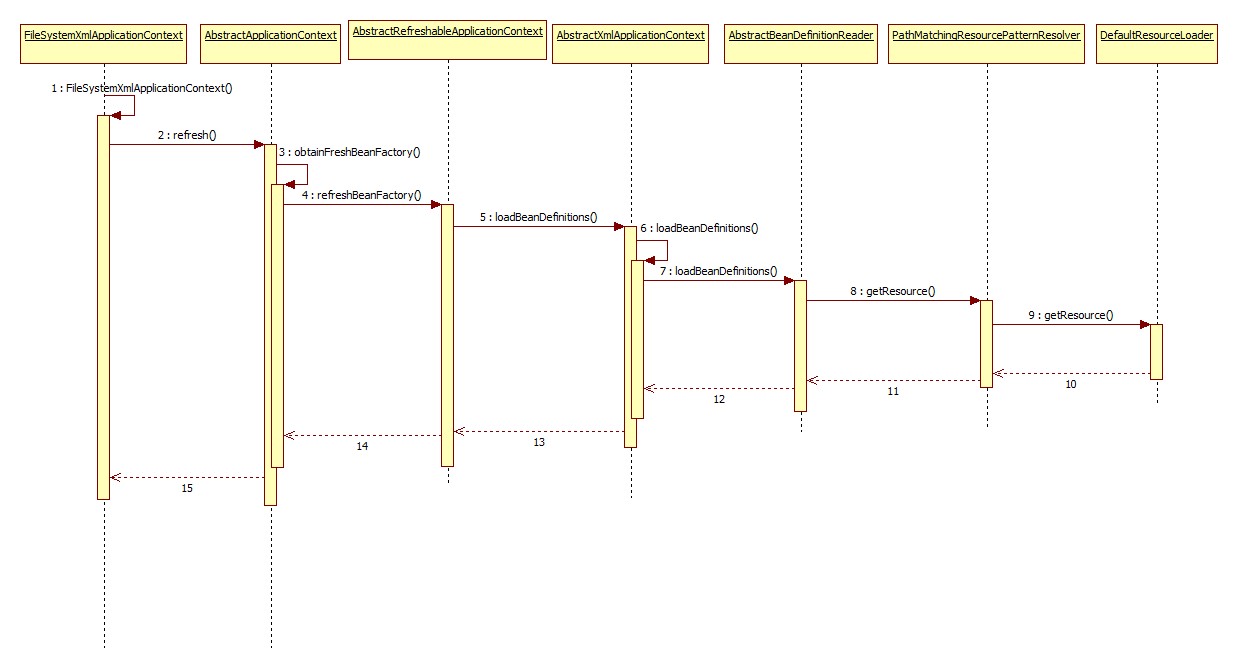了解完了FileSystemXmlApplicationContext构造函数,我们来看看路径解析的问题。
- 支持路径格式的研究。(绝对?相对?通配符?classpath格式又如何?
- 路径如何解析?
下面,我们就来一一验证和解答。先放出本次测试用的配置文件(app-context.xml和test.properties):
<bean id="placeHolderConfig"
class="org.springframework.beans.factory.config.PropertyPlaceholderConfigurer">
<property name="systemPropertiesModeName" value="SYSTEM_PROPERTIES_MODE_OVERRIDE" />
<property name="locations">
<list>
<value>classpath*:spring/test.properties</value>
</list>
</property>
</bean>
<bean id="veryCommonBean" class="kubi.coder.bean.VeryCommonBean">
<property name="name" value="${test.name}"></property>
</bean>
test.properties
test.name=verycommonbean-name
首先想到的自然是最普通的绝对路径:
/**
* 测试通过普通的绝对路径:
* <p>D:\\workspace-home\\spring-custom\\src\\main\\resources\\spring\\app-context.xml</p>
* 读取配置文件
*
* @author lihzh
* @date 2012-5-5 上午10:53:53
*/
@Test
public void testPlainAbsolutePath() {
String path = "D:\\workspace-home\\spring-custom\\src\\main\\resources\\spring\\app-context.xml";
ApplicationContext appContext = new FileSystemXmlApplicationContext(path);
assertNotNull(appContext);
VeryCommonBean bean = appContext.getBean(VeryCommonBean.class);
assertNotNull(bean);
assertEquals("verycommonbean-name", bean.getName());
}
测试通过,我们来看下Spring是怎么找到该文件的。之前已经说过refresh这个函数,是Spring生命周期的开始,我们就以它为入口,顺藤摸瓜,时序图如下

最终,我们找到解析路径的关键方法,PathMatchingResourcePatternResolver的getResources方法和DefaultResourceLoader中的getResource方法:
public Resource[] getResources(String locationPattern) throws IOException {
Assert.notNull(locationPattern, "Location pattern must not be null");
if (locationPattern.startsWith(CLASSPATH_ALL_URL_PREFIX)) {
// a class path resource (multiple resources for same name possible)
if (getPathMatcher().isPattern(locationPattern.substring(CLASSPATH_ALL_URL_PREFIX.length()))) {
// a class path resource pattern
return findPathMatchingResources(locationPattern);
}
else {
// all class path resources with the given name
return findAllClassPathResources(locationPattern.substring(CLASSPATH_ALL_URL_PREFIX.length()));
}
}
else {
// Only look for a pattern after a prefix here
// (to not get fooled by a pattern symbol in a strange prefix).
int prefixEnd = locationPattern.indexOf(":") + 1;
if (getPathMatcher().isPattern(locationPattern.substring(prefixEnd))) {
// a file pattern
return findPathMatchingResources(locationPattern);
}
else {
// a single resource with the given name
return new Resource[] {getResourceLoader().getResource(locationPattern)};
}
}
}
public Resource getResource(String location) {
Assert.notNull(location, "Location must not be null");
if (location.startsWith(CLASSPATH_URL_PREFIX)) {
return new ClassPathResource(location.substring(CLASSPATH_URL_PREFIX.length()), getClassLoader());
}
else {
try {
// Try to parse the location as a URL...
URL url = new URL(location);
return new UrlResource(url);
}
catch (MalformedURLException ex) {
// No URL -> resolve as resource path.
return getResourceByPath(location);
}
}
}
其中常量
CLASSPATH_ALL_URL_PREFIX = "classpath*:";
CLASSPATH_URL_PREFIX = "classpath:";
我们输入的路径是绝对路径:”D:\workspace-home\spring-custom\src\main\resources\spring\app-context.xml”。不是以classpath*开头的,所以会落入else之中。在else中:getPathMatcher().isPattern(),实际是调用AntPathMatcher中的isPattern()方法:
public boolean isPattern(String path) {
return (path.indexOf('*') != -1 || path.indexOf('?') != -1);
}
是用来判断”:”以后的路径中是否包含通配符”*“或者 “?”。我们的路径显然也不包含,所以最终会直接走入getResource方法。
路径仍然既不是以classpath开头的,也不是URL格式的路径,所以最终会落入getResourceByPath(location)这个分支,而我们之前介绍过,这个方法恰好是在FileSystemXmlApplicationContext这个类中复写过的
protected Resource getResourceByPath(String path) {
if (path != null && path.startsWith("/")) {
path = path.substring(1);
}
return new FileSystemResource(path);
}
我们给的路径不是以”/”开头,所以直接构造了一个FileSystemResource
public FileSystemResource(String path) {
Assert.notNull(path, "Path must not be null");
this.file = new File(path);
this.path = StringUtils.cleanPath(path);
}
即用路径直接构造了一个File。这里StringUtil.cleanPath方法主要是将传入的路径规范化,比如将windows的路径分隔”\“替换为标准的”/”,如果路径中含有”.”(当前文件夹),或者”..”(上层文件夹),则计算出其真实路径。而File本身是支持这样的路径的,也就是说,spring可以支持这样的路径。出于好奇,我们也针对这个方法测试如下:
/**
* 测试通过含有.或者..的绝对路径
* <p>D:\\workspace-home\\spring-custom\\.\\src\\main\\resources\\spring\\..\\spring\\app-context.xml</p>
* 读取配置文件
*
* @author lihzh
* @date 2012-5-5 上午10:53:53
*/
@Test
public void testContainDotAbsolutePath() {
String path = "D:\\workspace-home\\spring-custom\\.\\src\\main\\resources\\spring\\..\\spring\\app-context.xml";
ApplicationContext appContext = new FileSystemXmlApplicationContext(path);
assertNotNull(appContext);
VeryCommonBean bean = appContext.getBean(VeryCommonBean.class);
assertNotNull(bean);
assertEquals("verycommonbean-name", bean.getName());
}
容器可以正常初始化。路径计算正确。
补充说明:Spring最终读取配置文件,是通过InputStream加载的,Spring中的各种Resource的最上层接口InputStreamResource中定义了唯一的一个方法getInputStream。也就是说,只要保证各Resource的实现类的getInputStream方法能够正常获取流,Spring容器即可解析初始化。
对于FileSystemResource而言,其实现如下:
/**
* This implementation opens a FileInputStream for the underlying file.
* @see java.io.FileInputStream
*/
public InputStream getInputStream() throws IOException {
return new FileInputStream(this.file);
}
所以,我们说,此时只有是File正常支持的格式,Spring才能正常初始化。
继续回到前面的话题。我们目前只验证else分支中的catch分支。根据代码分析,即使是FileSystemXmlApplicationContext也可以支持Classpath格式的路径和URL格式的路径的。验证如下
/**
* 测试通过含有.或者..的绝对路径
* <p>file:/D:\\workspace-home\\spring-custom\\src\\main\\resources\\spring\\app-context.xml</p>
* 读取配置文件
*
* @author lihzh
* @date 2012-5-5 上午10:53:53
*/
@Test
public void testURLAbsolutePath() {
String path = "file:/D:\\workspace-home\\spring-custom\\src\\main\\resources\\spring\\app-context.xml";
ApplicationContext appContext = new FileSystemXmlApplicationContext(path);
assertNotNull(appContext);
VeryCommonBean bean = appContext.getBean(VeryCommonBean.class);
assertNotNull(bean);
assertEquals("verycommonbean-name", bean.getName());
}
/**
* 测试通过Classpath类型的路径
* <p>classpath:spring/app-context.xml</p>
* 通过读取配置文件
*
* @author lihzh
* @date 2012-5-5 上午10:53:53
*/
@Test
public void testClassPathStylePath() {
String path = "classpath:spring/app-context.xml";
ApplicationContext appContext = new FileSystemXmlApplicationContext(path);
assertNotNull(appContext);
VeryCommonBean bean = appContext.getBean(VeryCommonBean.class);
assertNotNull(bean);
assertEquals("verycommonbean-name", bean.getName());
}
验证通过,并且通过debug确认,确实走入了相应的分支,分别构造了UrlResource和ClassPathResource实例。所以,之后Spring会分别调用这个两个Resource中的getInputStream方法获取流,解析配置文件。附上这两个类中的getInputStream方法,有兴趣的可以继续研究。
/**
* This implementation opens an InputStream for the given URL.
* It sets the "UseCaches" flag to <code>false</code>,
* mainly to avoid jar file locking on Windows.
* @see java.net.URL#openConnection()
* @see java.net.URLConnection#setUseCaches(boolean)
* @see java.net.URLConnection#getInputStream()
*/
public InputStream getInputStream() throws IOException {
URLConnection con = this.url.openConnection();
ResourceUtils.useCachesIfNecessary(con);
try {
return con.getInputStream();
}
catch (IOException ex) {
// Close the HTTP connection (if applicable).
if (con instanceof HttpURLConnection) {
((HttpURLConnection) con).disconnect();
}
throw ex;
}
}
/**
* This implementation opens an InputStream for the given class path resource.
* @see java.lang.ClassLoader#getResourceAsStream(String)
* @see java.lang.Class#getResourceAsStream(String)
*/
public InputStream getInputStream() throws IOException {
InputStream is;
if (this.clazz != null) {
is = this.clazz.getResourceAsStream(this.path);
}
else {
is = this.classLoader.getResourceAsStream(this.path);
}
if (is == null) {
throw new FileNotFoundException(
getDescription() + " cannot be opened because it does not exist");
}
return is;
}
上述两个实现所属的类,我想应该一目了然吧~~
至此,我们算是分析验证通过了一个小分支下的支持的路径的情况,其实,这只是这些都是最简单直接的。回想刚才的分析,如果路径包含通配符(?,*)spring是怎么处理的?如果是以classpath*开头的又是如何呢?我们下回分解……

